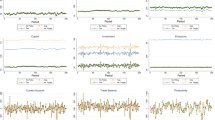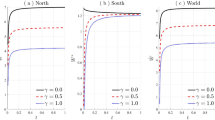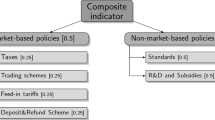Abstract
To control greenhouse gas emissions efficiently, we should regulate all pollution emission sources in the economy equally. However, in the real world, environmental regulations differ by sector. Using a small open economy model, this paper examines how the enforcement of an economy-wide emissions trading system (ETS) (i.e., uniform environmental regulation) affects welfare under a trade policy, where the government initially implements different environmental regulations across sectors. It is important to consider this relation between environmental regulations and trade policy because countries tend to impose weak environmental regulations in sectors facing global competition often protected by import tariffs. We find that an economy-wide ETS may harm a small open economy even under a low import tariff rate as long as the environmental regulation in the exporting industry is weaker than in the importing industry. To avoid welfare deterioration, the government should then decrease the import tariff rate in line with mitigation of the sectoral differences in environmental regulation.

Similar content being viewed by others
Notes
For example, the European Union (EU) ETS does not cover all emitted sources, although there is no differentiation across the ETS-regulated sectors at least in terms of permit prices. The coverage of the EU ETS in Phase 3 (2013–2020) has increased compared with that of Phase 2 (2008–2012), but by less than 50 %. Other examples are: (1) there are several regional ETSs in the US and Canada, including the US sulfur dioxide (SO2) allowance-trading program, the Regional Greenhouse Gas Initiative (RGGI), and the Western Climate Initiative (WCI); (2) Japan has the Experimental Integrated ETS (2008–) but the number of participants is limited because membership is voluntary.
For example, Böhringer et al. (2009) considered EU climate policy and found that a policy with different carbon prices for different industries could make environmental policy more costly.
We have not yet observed pollution content tariffs in the real world because there remains a debate about whether they are strictly compatible with World Trade Organization (WTO) rules (e.g., WTO 2009).
We could use a political economy model such as Grossman and Helpman (1994) to justify positive tariffs in our small open economy model. However, this would make it difficult to interpret our results without adding any new insights.
As we allow the movement of permits between sectors in the following section, we can also interpret our model as a Heckscher–Ohlin model with a mobility restriction in the factor market.
Pollution permits move between sectors with a change in environmental policy. In the existing literature, a specific factor can move between sectors under an adjustment process (e.g., economic resources for transforming a specific factor into a factor employable in other sectors). See, e.g., Mussa (1974, 1978), Neary (1978a, b), and Takarada (2004, 2006) for the adjustment process of a specific factor in the specific-factors model.
The level of \( Z \) does not matter to our main result as long as it is fixed.
Equation (4′) can consider the case of \( \theta < 1 \), but we would need to rewrite it to examine the other case (\( \theta > 1 \)). However, by using Eq. (5), we can investigate both cases without rewriting. Therefore, we use the approach in Eq. (5), which treats the changes in the permit prices as exogenous.
The implication of \( \Delta > 0 \) is that the government may impose strict environmental regulation in the less emissions-intensive sector but does not impose extremely strict regulation in that sector. For example, we could have \( e_{1} > e_{2} \) and \( r_{2} > r_{1} \) but the value of \( r_{2} \) cannot be too large because \( \left( {e_{1} - e_{2} } \right)\left( {e_{1} - \theta e_{2} } \right) > 0 \) holds if and only if \( \Delta > 0 \). Such a case could occur when it is costly to reduce emissions, even if goods are clean.
We can easily verify this change in the output of goods. From Eqs. (1–3), \( \Delta {\text{d}}L_{1} = p_{1} X_{Z}^{1} \left( {p_{1} X_{LZ}^{1} + p_{2} X_{LZ}^{2} } \right){\text{d}}\theta > 0 \) and \( \Delta {\text{d}}Z_{1} = - p_{1} X_{Z}^{1} \left( {p_{1} X_{LL}^{1} + p_{2} X_{LL}^{2} } \right){\text{d}}\theta > 0 \).
Bhagwati (1958) initially demonstrated the possibility of immiserizing growth in a large open economy model without import tariffs.
To make the implication of our result clear, we do not use the necessary and sufficient conditions, \( \hat{\theta } \le \theta \le 1 \), in the proposition because the expression of \( \hat{\theta } \) is complicated and it would be difficult to interpret our result without adding any new insights.
References
Bhagwati J (1958) Immiserizing growth: a geometrical note. Rev Econ Stud 25:201–205
Böhringer C, Rutherford TF, Tol RSJ (2009) The EU 20/20/2020 targets: an overview of the EMF 22 assessment. Energy Econ 31:268–273
Copeland BR (1994) International trade and the environment: policy reform in a polluted small open economy. J Environ Econ Manag 26:44–65
Copeland BR, Taylor MS (2003) Trade and the environment: theory and evidence. Princeton University Press, Princeton
Copeland BR, Taylor MS (2005) Free trade and global warming: a trade theory view of the Kyoto protocol. J Environ Econ Manag 49:205–234
Dixit AK, Norman V (1980) Theory of international trade: a dual general equilibrium approach. Cambridge University Press, Cambridge
Grossman GM, Helpman E (1994) Protection for sale. Am Econ Rev 84:833–850
Hoel M (1996) Should a carbon tax be differentiated across sectors? J Public Econ 59:17–32
Johnson HG (1967) The possibility of income losses from increased efficiency or factor accumulation in the presence of tariffs. Econ J 77:151–154
Jones RW (1971) A three factor model in theory, trade and history. In: Bhagwati J, Jones RW, Mundell RA, Vanek J (eds) Trade, balance of payments and growth: papers in International Economics in Honor of Charles P. Kindleberger, North-Holland, Amsterdam, pp 3–21
Lerner AP (1936) The symmetry between import and export taxes. Economica 3:306–313
Marschinski R, Flachsland C, Jakob M (2012) Sectoral linking of carbon markets: a trade-theory analysis. Resour Energy Econ 34:585–606
Mayer W (1974) Short-run and long-run equilibrium for a small open economy. J Polit Econ 82:955–967
Mussa M (1974) Tariffs and the distribution of income: the importance of factor specificity, substitutability, and intensity in the short and long run. J Polit Econ 82:1191–1204
Mussa M (1978) Dynamic adjustment in the Heckscher–Ohlin–Samuelson model. J Polit Econ 86:775–791
Neary JP (1978a) Dynamic stability and the theory of factor-market distortions. Am Econ Rev 68:671–682
Neary JP (1978b) Short-run capital specificity and the pure theory of international trade. Econ J 88:488–510
OECD (2013) Taxing energy use: a graphical analysis. OECD Publishing, Paris
Rauscher M (1997) International trade, factor movements, and the environment. Clarendon Press, Oxford
Sugiyama Y, Saito M (2009) Ecological dumping under foreign investment quotas. J Econ 98:137–153
Takarada Y (2004) Foreign aid, tariff revenue, and factor adjustment costs. Jpn World Econ 16:231–242
Takarada Y (2006) Welfare effects of technology transfer. Pac Econ Rev 11:75–86
Takeda S (2005) The effect of differentiated emission taxes: does an emission tax favor industry? Econ Bull 17:1–10
WTO (2009) Trade and climate change: a report by the United Nations Environment Programme and the World Trade Organization. World Trade Organization, Geneva
Acknowledgments
The authors are grateful to two anonymous referees, the editor, and seminar participants at the Research Institute of Economy, Trade and Industry (RIETI), Nagoya University, the University of Bari, the 2014 Annual Meeting of the Association of Southern European Economic Theorists (ASSET), and the 79th Annual Meeting of the Midwest Economics Association for their helpful comments and suggestions. Takarada gratefully acknowledges the financial support of a Japan Society for the Promotion of Science (JSPS) Grant-in-Aid for Scientific Research (C) #26380335, a JSPS Grant-in-Aid for Scientific Research (A) #16H02018, a Grant-in-Aid from the Zengin Foundation for Studies on Economics and Finance #1420, and a Nanzan University Pache Research Subsidy I-A-2 for the 2015 academic year. Tsubuku gratefully acknowledges the financial support of a JSPS Grant-in-Aid for JSPS Fellows #15J11103. Okimoto gratefully acknowledges the financial support of a JSPS Grant-in-Aid for JSPS Fellows #23-3981. All remaining errors are our own.
Author information
Authors and Affiliations
Corresponding author
Appendices
Appendix 1: Derivation of Eq. (5)
Using \( Z_{2} = Z - Z_{1} \) and totally differentiating Eqs. (1–3), we obtain
\( \Delta \) represents the Jacobian determinant of the system given by Eqs. (2) and (3).
Using the properties of homogeneous functions, \( X_{LZ}^{i} = - e_{i} X_{ZZ}^{i} = - X_{LL}^{i} /e_{i} = X_{ZL}^{i} \), we can rewrite the Jacobian determinant as \( \Delta = p_{1} X_{LL}^{1} p_{2} X_{LL}^{2} \left( {e_{1} } \right)^{2} \left( {e_{1} - e_{2} } \right)\left( {e_{1} - \theta e_{2} } \right) \).
From Eq. (4), using Eqs. (1–3) and \( p_{1} = \left( {1 + t} \right)p_{1}^{*} \), we have
Substituting Eqs. (7) and (8) for the above equation, we have
which is equal to Eq. (5).
Appendix 2: Stability condition
We consider the dynamic system consisting of Eqs. (2) and (3) as follows:
Linearizing the system at the equilibrium values of the variables, \( L_{1}^{*} \) and \( Z_{1}^{*} \), we derive
where \( {\text{d}}L_{1} = L_{1} - L_{1}^{*} \) and \( {\text{d}}Z_{1} = Z_{1} - Z_{1}^{*} \).
From the Routh–Hurwitz theorem, the equilibrium is locally stable if \( - B + \theta p_{1} X_{ZZ}^{1} + p_{2} X_{ZZ}^{2} < 0 \) and the Jacobian determinant \( \Delta \) is positive.
Appendix 3: Approach of the piecemeal reform
Totally differentiating these equations, we obtain
where \( C = \theta p_{1} X_{ZL}^{1} + p_{2} X_{ZL}^{2} > 0 \) and \( D = - \left( {\theta p_{1} X_{ZZ}^{1} + p_{2} X_{ZZ}^{2} } \right) > 0 \).
Totally differentiating the expenditure function \( E\left( {p_{1} ,p_{2} ,u,Z} \right) \), we derive
Substituting Eqs. (9) and (10) for the above equation, we obtain
We know that \( \gamma > 0 \) always holds. From Eq. (11), we can characterize the path for \( {\text{d}}u \ge 0 \) as
About this article
Cite this article
Takarada, Y., Tsubuku, M. & Okimoto, M. Trade and the emissions trading system in a small open economy. Environ Econ Policy Stud 19, 391–403 (2017). https://doi.org/10.1007/s10018-016-0163-4
Received:
Accepted:
Published:
Issue Date:
DOI: https://doi.org/10.1007/s10018-016-0163-4




